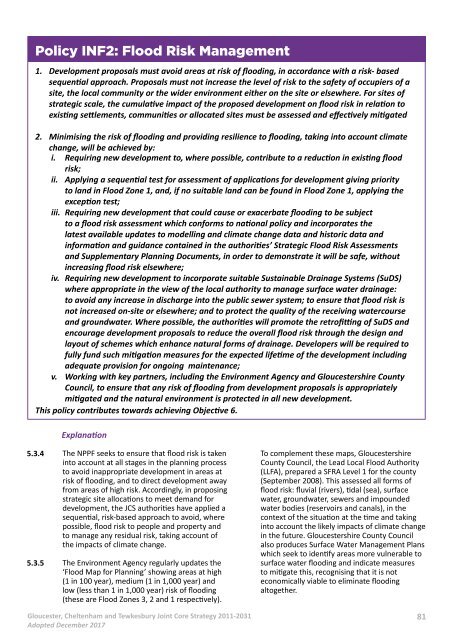JCS_MasterDocument_FIN_27.03.18
You also want an ePaper? Increase the reach of your titles
YUMPU automatically turns print PDFs into web optimized ePapers that Google loves.
Policy INF2: Flood Risk Management<br />
1. Development proposals must avoid areas at risk of flooding, in accordance with a risk- based<br />
sequential approach. Proposals must not increase the level of risk to the safety of occupiers of a<br />
site, the local community or the wider environment either on the site or elsewhere. For sites of<br />
strategic scale, the cumulative impact of the proposed development on flood risk in relation to<br />
existing settlements, communities or allocated sites must be assessed and effectively mitigated<br />
2. Minimising the risk of flooding and providing resilience to flooding, taking into account climate<br />
change, will be achieved by:<br />
i. Requiring new development to, where possible, contribute to a reduction in existing flood<br />
risk;<br />
ii. Applying a sequential test for assessment of applications for development giving priority<br />
to land in Flood Zone 1, and, if no suitable land can be found in Flood Zone 1, applying the<br />
exception test;<br />
iii. Requiring new development that could cause or exacerbate flooding to be subject<br />
to a flood risk assessment which conforms to national policy and incorporates the<br />
latest available updates to modelling and climate change data and historic data and<br />
information and guidance contained in the authorities’ Strategic Flood Risk Assessments<br />
and Supplementary Planning Documents, in order to demonstrate it will be safe, without<br />
increasing flood risk elsewhere;<br />
iv. Requiring new development to incorporate suitable Sustainable Drainage Systems (SuDS)<br />
where appropriate in the view of the local authority to manage surface water drainage:<br />
to avoid any increase in discharge into the public sewer system; to ensure that flood risk is<br />
not increased on-site or elsewhere; and to protect the quality of the receiving watercourse<br />
and groundwater. Where possible, the authorities will promote the retrofitting of SuDS and<br />
encourage development proposals to reduce the overall flood risk through the design and<br />
layout of schemes which enhance natural forms of drainage. Developers will be required to<br />
fully fund such mitigation measures for the expected lifetime of the development including<br />
adequate provision for ongoing maintenance;<br />
v. Working with key partners, including the Environment Agency and Gloucestershire County<br />
Council, to ensure that any risk of flooding from development proposals is appropriately<br />
mitigated and the natural environment is protected in all new development.<br />
This policy contributes towards achieving Objective 6.<br />
Explanation<br />
5.3.4<br />
5.3.5<br />
The NPPF seeks to ensure that flood risk is taken<br />
into account at all stages in the planning process<br />
to avoid inappropriate development in areas at<br />
risk of flooding, and to direct development away<br />
from areas of high risk. Accordingly, in proposing<br />
strategic site allocations to meet demand for<br />
development, the <strong>JCS</strong> authorities have applied a<br />
sequential, risk-based approach to avoid, where<br />
possible, flood risk to people and property and<br />
to manage any residual risk, taking account of<br />
the impacts of climate change.<br />
The Environment Agency regularly updates the<br />
‘Flood Map for Planning’ showing areas at high<br />
(1 in 100 year), medium (1 in 1,000 year) and<br />
low (less than 1 in 1,000 year) risk of flooding<br />
(these are Flood Zones 3, 2 and 1 respectively).<br />
To complement these maps, Gloucestershire<br />
County Council, the Lead Local Flood Authority<br />
(LLFA), prepared a SFRA Level 1 for the county<br />
(September 2008). This assessed all forms of<br />
flood risk: fluvial (rivers), tidal (sea), surface<br />
water, groundwater, sewers and impounded<br />
water bodies (reservoirs and canals), in the<br />
context of the situation at the time and taking<br />
into account the likely impacts of climate change<br />
in the future. Gloucestershire County Council<br />
also produces Surface Water Management Plans<br />
which seek to identify areas more vulnerable to<br />
surface water flooding and indicate measures<br />
to mitigate this, recognising that it is not<br />
economically viable to eliminate flooding<br />
altogether.<br />
Gloucester, Cheltenham and Tewkesbury Joint Core Strategy 2011-2031<br />
Adopted December 2017<br />
81




